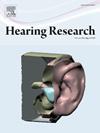脆性骨病小鼠模型听觉功能与听骨畸形骨折的关系
IF 2.5
2区 医学
Q1 AUDIOLOGY & SPEECH-LANGUAGE PATHOLOGY
引用次数: 0
摘要
听力损失是成骨不全症(OI)的普遍症状,成骨不全症是一组与i型胶原蛋白相关的骨骼疾病,通常被称为脆骨病。成骨不全患者听力损失的临床表现多为镫骨、足板固定和耳囊低密度灶。然而,oi型听力损失的病因、演变及其与骨异常的关系尚不清楚。本研究调查了严重OI III型纯合子小鼠模型中听力损失的发生、严重程度和进展情况,据报道,该模型在11-12周龄时表现出听力损失(Chen et al., 2007),使用听觉脑干反应直至26周龄。我们使用同步加速器显微断层扫描进一步检查听骨链畸形、微裂纹和骨折的存在。我们的研究结果表明,oim/oim小鼠的听力正常,无论i)亲代血统,ii)单独饲养或与其他动物饲养,iii)用粉末或食物咀嚼,iv)单次或多次注射氯胺酮麻醉。在每组中,高达33%的野生型和高达43%的oim/oim小鼠中观察到骨异常,如过度形成,融合和骨折。其中,与野生型小鼠相比,oim/oim小鼠的关节和骨肌腱异常频率是野生型小鼠的两倍。值得注意的是,这些异常并不影响小鼠的听力反应。骨不全患者是否会发生这种骨异常并改变听觉功能仍不确定。本文章由计算机程序翻译,如有差异,请以英文原文为准。
Hearing function and ossicular deformities and fractures in the oim mouse model of brittle bone disease
Hearing loss is a prevalent symptom of osteogenesis imperfecta (OI), a group of collagen type I-related skeletal disorders, commonly known as brittle bone disease. Clinical manifestation of hearing loss in OI often presents with stapes footplate fixation and hypodense foci in the otic capsule. However, the etiology and evolution of OI-hearing loss and its relation to bone abnormalities are still unknown. This study investigates the onset, severity, and progression of hearing loss in the homozygous oim mouse model of severe OI Type III, which is reported to exhibit hearing loss at 11-12 weeks of age (Chen et al., 2007), using auditory brainstem responses up to 26 weeks of age. We further examine the presence of deformities, microcracks, and fractures of the ossicular chain using synchrotron microtomography. Our results demonstrate that oim/oim mice have normal hearing, regardless of i) their parental lineage, ii) their husbandry in isolation or with other animals, iii) their mastication with powder or chow food, and iv) their anesthesia with single or multiple ketamine injections. Bone abnormalities like excessive formations, fusions, and fractures, were observed in up to 33 % of wild-type and up to 43 % of oim/oim mice in each group. Among these, joint and bone-tendon abnormalities were twice as frequent in the oim/oim mice compared to the wild-type mice. Notably, these abnormalities did not impact the hearing response in mice. Whether such bone abnormalities occur and alter auditory function in humans with OI remains uncertain.
求助全文
通过发布文献求助,成功后即可免费获取论文全文。
去求助
来源期刊

Hearing Research
医学-耳鼻喉科学
CiteScore
5.30
自引率
14.30%
发文量
163
审稿时长
75 days
期刊介绍:
The aim of the journal is to provide a forum for papers concerned with basic peripheral and central auditory mechanisms. Emphasis is on experimental and clinical studies, but theoretical and methodological papers will also be considered. The journal publishes original research papers, review and mini- review articles, rapid communications, method/protocol and perspective articles.
Papers submitted should deal with auditory anatomy, physiology, psychophysics, imaging, modeling and behavioural studies in animals and humans, as well as hearing aids and cochlear implants. Papers dealing with the vestibular system are also considered for publication. Papers on comparative aspects of hearing and on effects of drugs and environmental contaminants on hearing function will also be considered. Clinical papers will be accepted when they contribute to the understanding of normal and pathological hearing functions.
 求助内容:
求助内容: 应助结果提醒方式:
应助结果提醒方式:


